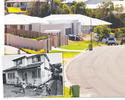High-density planning policies have become fashionable and Sydney planners are among the most enthusiastic adopters. New South Wales Government authorities claim that high density policies result in a reduction of greenhouse gas emissions (gge), provide improved housing affordability and result in reduced traffic congestion. No evidence has been provided to justify these assertions. Such claims need to be investigated as well as density’s detrimental effect on amenity and quality of life should also be investigated. read more »
Australia
Standard of Living Crisis Evident in New Demographia International Housing Affordability Survey
One of the principal advances of the past two centuries has been the drastic reduction in poverty and the rise of a large middle-class, a process expertly detailed by economists Diedre McClosky and Robert Gordon. read more »
- Login to post comments
Australia's China Syndrome
Australia continues to benefit from China’s rise, though few countries are more threatened by its expanding power. Once closely tied to the British Commonwealth, and later to the United States, the Australian subcontinent, with only 24 million people, now relies on China for one-third of its trade—more than with Japan and the U.S. combined. Australia’s major economic sectors rely on Chinese support; investors poured in $17.4 billion in 2017. read more »
- Login to post comments
Affordability, Housing Shortages and the Coming Population Boom
Housing affordability and dwelling shortages back to centre stage
The combined issues of housing affordability and dwelling shortages are once again emerging as key issues for the property industry, policy makers and the broader community.
Recent cyclical and relatively short-term movements in the property market – where we’ve moved from boom to moderation to a rebound again – have dominated discussion in recent years. read more »
- Login to post comments
Stomping On the Suburbs
Our way of life is a miracle for this kind of world, and … the danger lies in thinking that of it as ‘natural’ and likely to endure without a passionate determination on our part to preserve and defend it.” — W.V. Aughterson, The Australian Way of Life, 1951
For generations, Australia has enjoyed among the highest living standards in the world. The “Australian dream”, embodied largely by owning a single-family home with a small backyard, included well over 70 per cent of households. read more »
- Login to post comments
Australia's Long Suffering Commuters
Daily commute times are ballooning in Australia's largest capital cities (metropolitan areas, called Greater Capital City Statistical Areas). This is a finding of the latest Household, Income and Labour Dynamics in Australia (HILDA) Survey. The HILDA Survey is conducted across the nation by the University of Melbourne. read more »
- Login to post comments
Is It Time To Rethink Density?
With new forecasts of record population growth across Australia’s major capital cities over the next few decades and affordability remaining a challenge, is it time to reconsider the core principles and policies that guide the management of this growth? read more »
Who Needs Democracy Anyway?
On the 18th June this year, climate change demonstrators glued themselves to a main street in the centre of Brisbane, protesting what they regard as a climate emergency and to voice their objection to the recent approval of the Adani coal mine in Australia’s Galilee basin. Their protest caused major disruptions to CBD traffic and has since continued with a series of deliberate actions to block inner city streets and cause as much congestion and disruption as possible. read more »
- Login to post comments
The “New Zealand Dream” is Still Alive
The promotion of middle-income home ownership long has been a policy priority of governments around the world. This includes New Zealand, as Gael Ferguson indicated in The New Zealand Dream, published in 1994: read more »
- Login to post comments
Making Life Worse: The Flaws of Green Mandates
“Saving the planet” should be an unbeatable political slogan. Yet consistently the imagined “green wave” mindlessly embraced by most of the media continues to fall short, as evidenced by recent elections in Canada and Australia, as well as across much of Europe. read more »
- Login to post comments





















